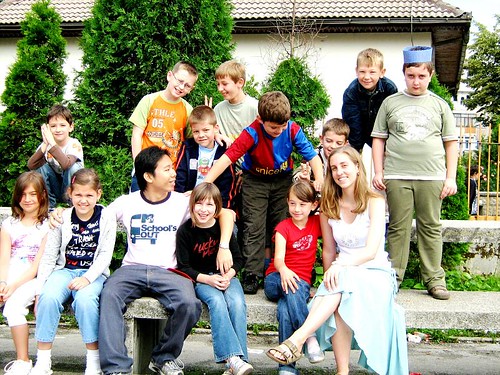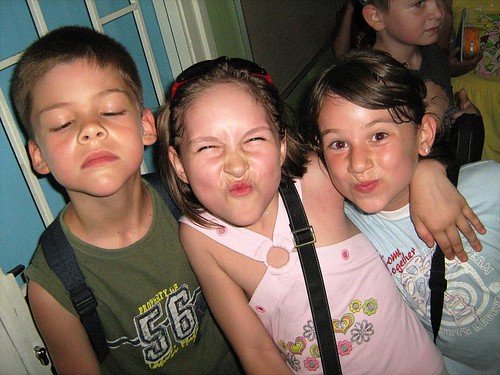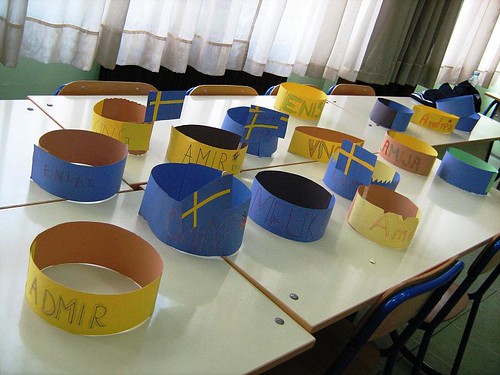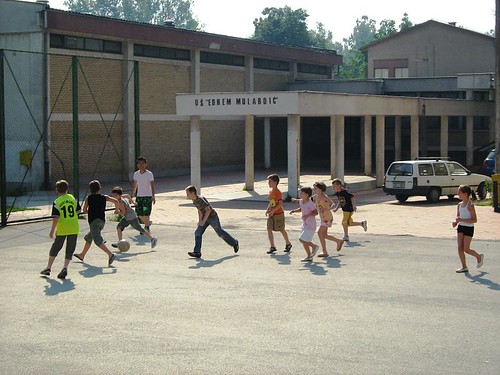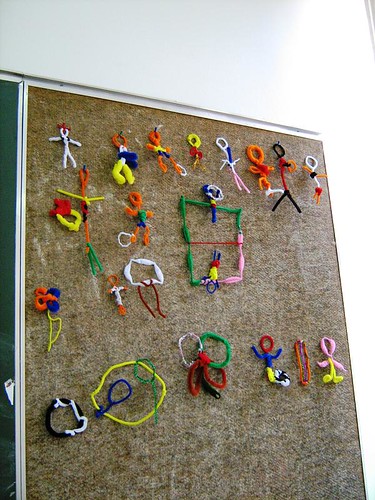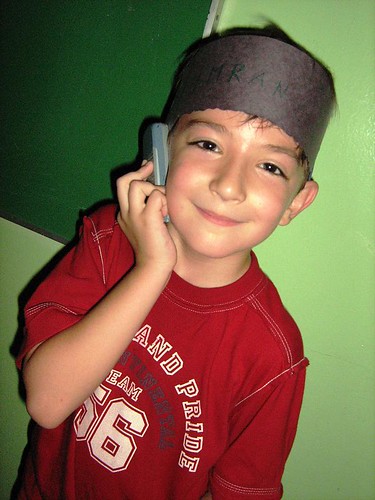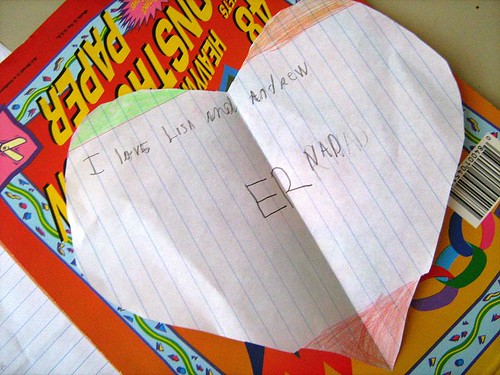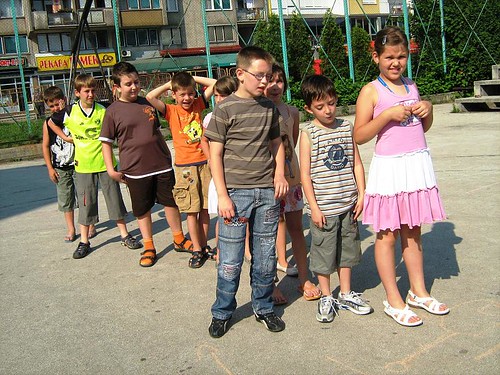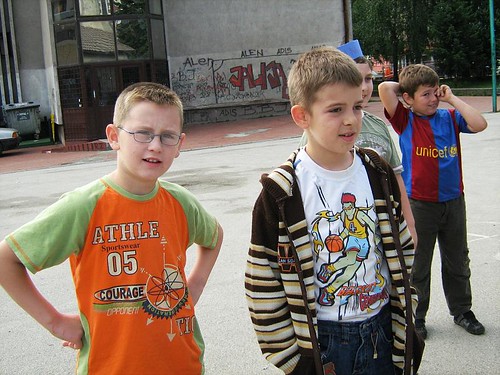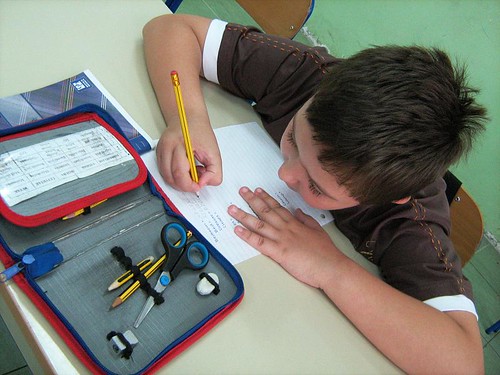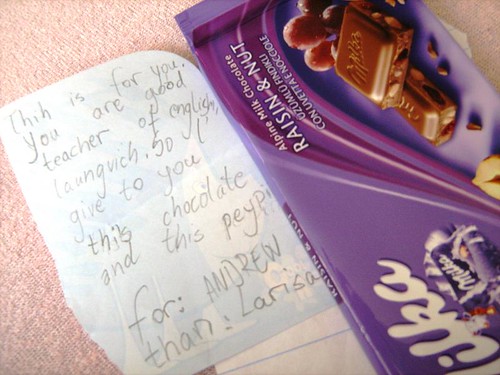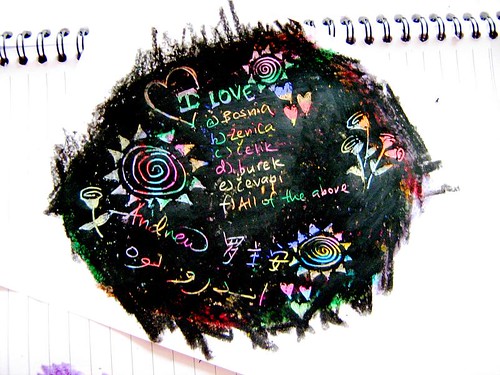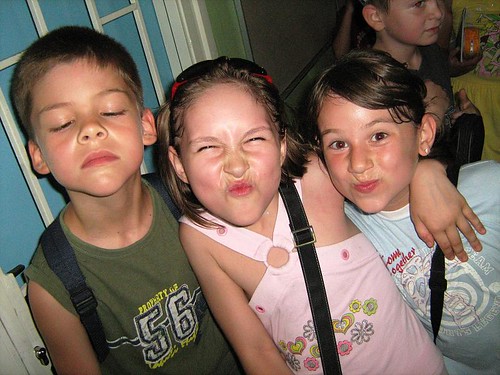Thurs,June 26, 6pm
Again, I'm writing this at home and I'll post it when I get online tomorrow afternoon.
Teaching is going well, although it can be tiring. Deivid and I have the youngest groups during the 3 sessions, first 5-7 year olds, then about 10, then about 12. Our youngest group can be a little wild, and the oldest boys can also get wild, while the middle group is the easiest in terms of classroom control but in some ways the most challenging for coming up with activities (they are too young for some drama games and writing activities, too old for songs). These are rough ages; in the middle and last classes we've got 3 sisters 10-12 and 11-12. The middle class sisters are shy and less proficient at English while the three in the last class are our best English speakers (and one of them, our biggest show off). Some of the kids are really quite good at English while others struggle, and some are just shy. One of the most valuable things about this program, though, is to overcome shyness and insecurities about their English abilities and give them a fun and encouraging environment to just practice speaking, as opposed to the grammar drills and such that occur during the school year in their English classes.
Deivid and I do a bit of fun review and reinforcement along with the new vocabulary we try to introduce each day. So, for example, today (Thursday) we did jeopardy with the oldest group, going over places around town, modes of transportation, some of the international stuff we've covered on Wednesdays, and some spelling. With the youngest group we showed them some pictures and had them tell us what they were. I'm also quite fond of singing songs with the youngest group, to go along with body parts they know Head, Shoulders, Knees and Toes and Hokey Pokey, and today we added If You're Happy and You Know It, and for directional words I taught them The Wheels on the Bus.
To encourage the older ones to talk for longer, we have done a few individual competitive games with them as well as some of the group games and competitions. It seems to work really well with the oldest class, particularly the quieter boys, to ask them to draw a picture of something and then have a contest for describing it (who can talk the longest and most properly). We've done this on "transportation" day with their imaginary cars, and on "around the town/places" day with their favorite (real or imagined) location. Competition does seem to get the quiet ones talking a little more, but I worry about the balance between scoring fairly and discouraging the ones who talk more than they usually do but still come out among the last, which is especially noticeable with the overt scoring system of us putting numbers on the board.
Lisa and I teamed up to do Ghana for international day yesterday and finally hit that inevitable moment where something in one language evokes giggles due to its meaning in another language. I covered some facts about Ghana while Lisa, who takes African dance, taught a few lines of a song and a few dance steps. It turned out that the name of the song/dance, "Kaki Lombe," sounded like the bosnian phrase for "shit town," causing especially the 9-13 year old boys to giggle. It took several classes for someone to tell us why they were so amused.
~ ~ ~ ~ ~
Besides school, it's been quite hot, in the 90s. I've fallen into a routine of waking up around 7:15 to eat oatmeal and prepare a snack (fruit, sandwich of bread and cheese) for school and take on the 20+ minute walk in the growing heat, teach from 8:15 until 1:15, go out for coffee or ice cream and plan the next day, head to the library for internet access and reading material (The Economist! Novels! Things I never had time for at Swat.). I get home around 4pm for the big meal of the day, which is nice to have earlier in the day. After the meal I read, but in this heat I've been dosing off. Many nights we meat for "coffee" (Bosnian terminology, I can't handle it that late in the day but I'm happy to have beer/"pivo" or fresh squeezed lemonade, served unsweetened and with sugar on the side).
As for the food, I've been loving pie ("pita"), especially burek, which is the mince meat pie. Pita is meat, cheese, squash, or another filling inside of narrow tubes of dough rolled into a coil or served in strips. I've also been served fish sticks, brocoli, and fried eggplant with feta, olive oil, and of course bread and salad of tomatoes peppers and cucumbers; some sort of meat, beans, mushrooms dish today with a miniature burek and of course bread and salad; mushroom cream soup or mushrooms with risotto and of course bread and salad.....Last Sunday we went out to Zenica's best Cevapi (chevapi) place. Cevapi are little meat patties served with delicious fresh bread (in a naan-like form) and onion, usually ordered along with salad and drinkable yogurt (which helps with the onion breath). Around 8 or 9pm my host mom has a snack of bread, cheese, and oil, and/or fruit, and/or ice cream, and/or a small amount of leftovers from dinner, and I join her if I'm around or hungry.
Last week we went out to see Turkey-Croatia in the Eurocup quarters. We went to a little microbrewery that served beer with a hoppy flavor, which I really appreciated given that the regional beers are rather poor lagers. The place is apparently quite crowded during the winter, but it's got none of the outdoor seating that is so popular in the summer, so few people were there. Croatia is none too popular in Bosnia, while Turkey is loved (the Turks ruled the Balkans for a long, long time), so the last-minute way in which the game was decided for Turkey caused much horn-honking and some firecracker explosions, similar, actually, to the reaction of my hometown fans in Boston when our teams win big games.
Last night and tonight (Wed and Thurs) are the Eurocup semis so there are big screens set up at cafes/bars to watch the games. Turkey-Germany was last night and I was in a very small minority rooting for Germany. However, apparently due to storms in Austria (hosting the cup), the signal was dropped 3 times. The first time the game remained 1-1. The second time the signal resumed, they were just showing a replay of a Turkey goal, and the cafe went crazy, but I waited for the score to reappear onscreen. Everyone slouched when it turned out to be not 2-1 Turkey but tied at 2; it was quite amusing. Then just after Germany scored in the final minutes to make it 3-2 the signal went out and when it returned the German team was celebrating onscreen. A little anticlimactic but an amusing incident.
Last anecdote - Alma, one of the hosts and a translator for us, commented to me the other day over one of her 3-4 coffee dates that day that us Americans were very cheap. The comment was inspired by several Americans' reluctance to buy coffee (1-1.5 KM) at one of our once or twice daily coffee dates. I thought about this and explained to her that it must be a cultural difference. Americans don't have the same quality of coffee and when we drink it, we either make it at home or go grab a solitary cup en route to somewhere or with our laptops at Starbucks, while Bosnians make several coffee dates with friends throughout the day and night. So it is just a natural part of daily life and budgeting for them, while some Americans coming to Bosnia didn't consider that they would spend $2 a day on the social norm and are reluctant, despite our country's comparative wealth, to adjust their budgets accordingly, especially with our student bank accounts. She agreed with this assessment and added that while she has no bank account and only X KM in her possession, of course she'd buy coffee and so will everyone else in Bosnia; it's a cultural difference both in social custom and attitude towards saving money.





